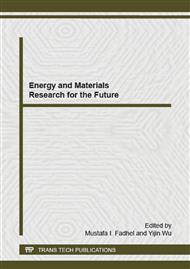[1]
XU Qing-hai, MING Xia. Extraction on natural pigment and its physiological functions [J]. Applied Chemical Industry. 2005, 34(5): 268~273.
Google Scholar
[2]
TANG Chuan-he, PENG Zhi-ying. Physiological Function and Application Prospects of the Natural Anthocyanin Pigments [J]. Food Additives. 2000(1): 26~28.
Google Scholar
[3]
WANG Feng, TAN Xing-he, DENG Jie-hong. Study on the Stability of Black Peanut Skin Pigment [J]. Food & Machinery. 2007, 23(3): 53~57.
Google Scholar
[4]
WANG Hong-juan, LIAN Xi-jun, GUO Kun-liang. etc. Photostability Discussion on Method of Determination of Monascus Pigments Powder [J]. Food Science. 2005, 26(1): 201~204.
Google Scholar
[5]
LV Xiao-ling, WANG Ji, GONG Peng-fei. Study on the Extraction of Pigment from Purple Corn Cob [J]. Food Research and Development. 2006, 27(4), 76~78.
Google Scholar
[6]
LV Xiao-ning, ZHANG Shu-juan, FAN Hui. Study on Extraction Technology of Black Peanut Skin Pigment [J]. Food Research and Development. 2009, 30(5): 178~181.
Google Scholar
[7]
Ginsti M M, Wrolstad R E, Anthocyanins. Characterization and Measurement with UV-visible Spectroscopy [M]. New York: Current Protocols in Food Analytical Chemistry, (2006).
DOI: 10.1002/0471142913.faf0102s00
Google Scholar
[8]
CHEN Jun-hui, TAO Li, LI Jun. Biochemical Experiments [M]. Beijing: Science Press. 2003, 245.
Google Scholar
[9]
REN Yu-lin, LI Hua, BING Gui-de. Natural Edible Pigment–Anthocyanin [J]. Food Science. 1995, 16(7): 22~27.
Google Scholar
[10]
WANG Feng, TAN Xing-he, DENG Jie-hong. Study on Thermal Degradation Kinetics of Black Peanut Skin Pigments [J]. Study of Preservation. 2009(3): 16~19.
Google Scholar
[11]
HUANG Rong-feng, YANG Su-feng, WU Chun-xia. etc. Determination of Anthocyanin in Black Peanut Testae by HPLC [J]. Chinese Agriculture Science Bulletin. 2011, 27 (04): 311~315.
Google Scholar
[12]
LIU Li-yuan, YUAN Wei, LIU Yan-lin. Advances in Research of Red Wine's Anthocyanin Copigmentation [J]. Scientia Agricultura Sinica. 2010, 43(12): 2518~2526.
Google Scholar
[13]
ZHANG Li-rong, ZHANG Ming-wei, LIU Lin-wei. etc. Stability Comparison of Anthocyanin Extracts in Seed Coats of Three Black Crops [J]. Journal of Agricultural Machinery. 2007, 38(5): 91~95.
Google Scholar
[14]
ZHOU Yu, YAN Guo-hua, ZHANG Kai-chun. etc. Study on the Stability of Larkspitr Anthocyanin [J]. Food Research and Development. 2006, 27(4): 1~3.
Google Scholar
[15]
WANG Chao-chen. Study on the Stability of Grape Anthocyanin [J]. Agricultural Technology and Equipment. 2011(04): 7~8.
Google Scholar
[16]
WANG Xiao-lan. Organic Chemistry [M]. Beijing Higher Education Press. 2005, 144~147.
Google Scholar
[17]
LIU Da-chuan, LIU Qiang. Research on Extraction Technology of Resveratrol and Procyanidin from Red Skin of Peanut [J]. Food Science. 2005, 26(7): 144~147.
Google Scholar


